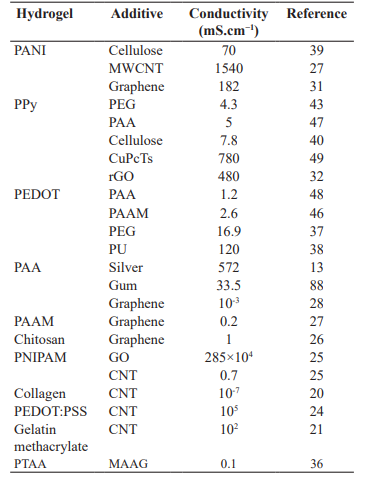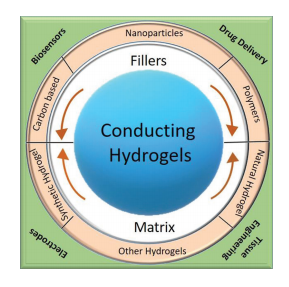Denmark: 3D Printing Conductive Hydrogels for Medical Applications
In the recently published ‘Electrically Conducting Hydrogels for Health care: Concept, Fabrication Methods, and Applications,’ Shweta Agarwala of the Department of Engineering at Aarhus University in Denmark researchers 3D printing techniques in the medical realm, offering a review of conductive hydrogels.
As 3D printing began to infiltrate the mainstream, industries such as automotive, aerospace, and construction have been positively impacted—and now, medical applications have gone beyond 3D models and devices as scientists continue to make huge strides in bioprinting. Scaffolds are a common structure used in tissue engineering featuring a variety of different hydrogels; however, they can also be used for a wide range of applications today, from smart wearables to biosensors, implants, and avenues to wound management.
Hydrogels are attractive for use in research and other applications due to:
- Ideal extracellular matrix (ECM)
- Cell support
- Biocompatibility
- Natural and synthetic hydrophilic polymer chains offering high absorption of water
“Although hydrogels have found niche application in tissue engineering, they are inherently insulating by nature. Recent research has shown that hydrogels not only possess necessary characteristics to support biological species but can also interface with electrical circuitry if modified,” states Agarwala. “Hence, research on conducting hydrogels have gained widespread interest for applications such as health recording electrodes.”
Agarwala notes that in general, the conductivity associated with hydrogels is ionic conductivity.

Summary of the material composites and their electrical conductivities achieved to make conducting hydrogels.
“The contribution from additives materials to overall conductivity in such cases is small. However, recent research efforts in this direction have shown promise in inducing electrical conductivity from the additive materials,” states Agarwala.
While the method most often used for aqueous compatible conducting materials is to use ultrasonic energy or heating, five other approaches are available:
- Hydrogel monomers with cross-linkers and nanoparticles are gelated together.
- Nanoparticles are physically embedded into the hydrogel matrix after gelation.
- Nanoparticle precursors are loaded into the gel.
- Cross-linking using nanoparticles forms hydrogels.
- Hydrogels are formed using nanoparticles, polymers, and other molecules.

Schematic diagram depicting various approaches to synthesize conducting hydrogel: (A) hydrogel monomers with cross-linkers and nanoparticles gelated together; (B) physically embedding nanoparticles into hydrogel matrix after gelation; (C) reactive nanoparticle formation aided by the hydrogel network where nanoparticle precursors are loaded in the gel; (D) cross-linking using nanoparticles to form hydrogel; and (E) hydrogel formation using nanoparticles, polymers, and other molecules.
One of the greatest benefits in 3D printing is that users are able to create much more complex geometries, along with enjoying enormous latitude in both design and customization, as well as being able to make projects faster, and make changes to them on demand. All of these benefits apply to why there has been such an increase in 3D printing conducting hydrogels.
Techniques usually rely on shear thinning, causing them to flow as pressure is applied, using a piezoelectric head.
“A piezoelectric material deforms on applying voltage or current. Thus, the orifice opening can be controlled by varying the voltage applied to the printer head. Inkjet printing creates small droplets (sub-micron volume), which are deposited on the surface,” states Agarwala. “Small volume of material deposition, as against large material ejection through extrusion, helps to print high-resolution constructs and scaffolds.
“Ink development is considered one of the most important aspects of 3D printing. Hydrogel inks need to have the right rheological properties to fulfill the physical and mechanical needs of the orienting process.”

Sketch of (A) 3D bioplotting system (Reproduced with permission [65]) (B) digital light projector (DLP) 3D printing system to 3D print conducting hydrogel scaffolds (Reproduced with permission [74]), and (C) stereolithography process (Reproduced with permission [75]).
“These materials are unable to follow the original design models, as the printed construct does not retain the original shape. Achieving functional gradients and hierarchical properties have also been challenging and new design approaches are being developed to tackle them,” concludes Agarwala.
“The area of conducting hydrogels is still full of unresolved technological challenges, and thus provides researchers with opportunity for development, as this field is growing fast beyond its early stage. Improvement in the conductivity of the hydrogels may be one research direction, while incorporating new functionalities such as biodegradability and mechanical strength can open new avenues for applications. Innovation is also required in fabrication methods to allow varied composition of hydrogels to be laid down in desired fashion.”
What do you think of this news? Let us know your thoughts! Join the discussion of this and other 3D printing topics at 3DPrintBoard.com.
[Source / Images: ‘Electrically Conducting Hydrogels for Health care: Concept, Fabrication Methods, and Applications’]Subscribe to Our Email Newsletter
Stay up-to-date on all the latest news from the 3D printing industry and receive information and offers from third party vendors.
Print Services
Upload your 3D Models and get them printed quickly and efficiently.
You May Also Like
Stifel’s AM Forward Fund Launches, Looking for US Manufacturers to Invest In
The need for greater resiliency in the defense supply chain is real and urgent. One area the US government has been focusing on is building a faster and more sustainable...
3D Printing Financials: Xometry Cuts Losses, Grows Platform
Xometry (Nasdaq: XMTR) is entering 2025 with momentum. The company delivered record quarterly revenue and narrowed its losses, showing progress toward profitability. More importantly, for those watching the future of...
3D Spark Secures $2.2M to Tackle Manufacturing Bottlenecks
German startup 3D Spark has raised two million euros in a seed round. Swedish software investor Triplefair Partners led the round, with Fraunhofer Technologie-Transfer Fonds (FTTF) and Innovationsstarter Fonds Hamburg...
3D Printing Financials: Protolabs Reports 3D Printing Dip, But Metal 3D Orders Grow
Protolabs (NYSE: PRLB) kicked off 2025 with a mixed but steady performance. Revenue remained close to expectations, profits dipped slightly from last year, and the company was profitable despite ongoing...






























